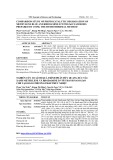
Hydrothermal temperature
Xem 1-1 trên 1 kết quả Hydrothermal temperature
-
In this study, we report on the hydrothermal synthesis of ZnO nanorods and the change in photocatalytic properties with different hydrothermal temperatures in the decomposition of Methylene blue (MB) and Rhodamine B (RhB) under visible light.
 11p
11p  viengfa
viengfa
 28-10-2024
28-10-2024
 2
2
 1
1
 Download
Download










